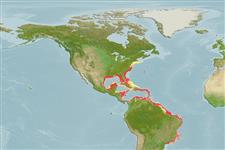Lớp phụ Cá sụn (cá mập và cá đuối) (sharks and rays) >
Carcharhiniformes (Ground sharks) >
Carcharhinidae (Requiem sharks)
Etymology: Rhizoprionodon: rhiza (Gr.), root; prion (Gr.) saw; odon (Gr.), tooth, referring to teeth with serrated (saw-like) bases, or roots [replacement name for Rhizoprion Ogilby 1915, preoccupied by Rhizoprion Jourdan 1861 in mammals] (See ETYFish); terraenovae: terra (L.), earth or land; novus (L.), new, i.e., Newfoundland, Canada, where Richardson erroneously thought it occurred (See ETYFish).
More on author: Richardson.
Environment: milieu / climate zone / Mức độ sâu / distribution range
Sinh thái học
Biển; Thuộc về nước lợ gần đáy; Mức độ sâu 0 - 280 m (Ref. 26938), usually 0 - 10 m (Ref. 55195). Subtropical; 43°N - 25°S, 100°W - 32°W (Ref. 55195)
Western Atlantic: New Brunswick, Canada to the Gulf of Mexico. Southwest Atlantic: coasts of Brazil.
Length at first maturity / Bộ gần gũi / Khối lượng (Trọng lượng) / Age
Chín muồi sinh dục: Lm 87.5, range 85 - 90 cm
Max length : 110 cm TL con đực/không giới tính; (Ref. 37512); 110.0 cm TL (female); common length : 70.0 cm TL con đực/không giới tính; (Ref. 37512); Khối lượng cực đại được công bố: 7.3 kg (Ref. 40637); Tuổi cực đại được báo cáo: 10 các năm (Ref. 6140)
Small, generally gray, streamlined shark, with long pointed snout. Posterior margin of anal fin straight or slightly concave. Second dorsal fin origin well behind anal fin origin (Ref. 26938).
Body shape (shape guide): fusiform / normal.
Reaches at least 103 cm TL (Ref. 244). Abundant in the continental shelves, from the intertidal to deeper waters. Often occurs close to the surf zone off sandy beaches, and also enclosed bays, sounds, and harbors, in estuaries and river mouths. Feeds on small bony fishes, shrimps, crabs, segmented worms and mollusks (gastropod feet). Viviparous, with 1 to 7 young in a litter (Ref. 27549). Size at birth about 29 to 37 cm. Utilized for human consumption. Minimum depth from Ref. 055195.
Distinct pairing with embrace (Ref. 205). Viviparous, placental (Ref. 50449). 1 to 7 young per litter. Larger females carry more young. Size at birth 29-37 cm. Gestation period is 10 to 11 months in the northern Gulf of Mexico. Sex ratio of near term fetuses is 1:1 (Ref. 244).
Compagno, L.J.V., 1984. FAO Species Catalogue. Vol. 4. Sharks of the world. An annotated and illustrated catalogue of shark species known to date. Part 2 - Carcharhiniformes. FAO Fish. Synop. 125(4/2):251-655. Rome: FAO. (Ref. 244)
IUCN Red List Status (Ref. 130435: Version 2025-1)
Threat to humans
Harmless
Human uses
Các nghề cá: Các nghề cá là sinh kế; cá để chơi: đúng
Các công cụ
Special reports
Download XML
Các nguồn internet
Estimates based on models
Preferred temperature (Tài liệu tham khảo
123201): 23.4 - 28, mean 27 °C (based on 1016 cells).
Phylogenetic diversity index (Tài liệu tham khảo
82804): PD
50 = 0.5078 [Uniqueness, from 0.5 = low to 2.0 = high].
Bayesian length-weight: a=0.00427 (0.00274 - 0.00664), b=3.00 (2.87 - 3.13), in cm total length, based on LWR estimates for this species & Genus-body shape (Ref.
93245).
Mức dinh dưỡng (Tài liệu tham khảo
69278): 4.4 ±0.5 se; based on diet studies.
Thích nghi nhanh (Tài liệu tham khảo
120179): Rất thấp, thời gian nhân đôi của chủng quần tối thiểu là hơn 14 năm (K=0.19-0.45(?); tmax=10; tm=4; Fec 1-7).
Fishing Vulnerability (Ref.
59153): Moderate to high vulnerability (50 of 100).
🛈
Climate Vulnerability (Ref.
125649): Very high vulnerability (85 of 100).
🛈
Nutrients (Ref.
124155): Calcium = 23.3 [2.5, 120.6] mg/100g; Iron = 0.89 [0.24, 2.75] mg/100g; Protein = 22.6 [19.7, 24.8] %; Omega3 = 0.372 [0.150, 0.861] g/100g; Selenium = 25.1 [6.4, 70.6] μg/100g; VitaminA = 8.35 [2.78, 24.50] μg/100g; Zinc = 0.452 [0.218, 0.855] mg/100g (wet weight); based on
nutrient studies.
